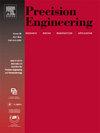Ultra-precision rotary scratching of concave blazed gratings
IF 3.7
2区 工程技术
Q2 ENGINEERING, MANUFACTURING
Precision Engineering-Journal of the International Societies for Precision Engineering and Nanotechnology
Pub Date : 2025-03-23
DOI:10.1016/j.precisioneng.2025.03.024
引用次数: 0
Abstract
Concave blazed gratings serve a fundamental role in miniaturized spectrometers, fulfilling the duties of both a plane grating and focusing mirror. However, common fabrication methods are often limited in terms of efficiency, precision or the range of machinable materials. To address the issue, the ultra-precision rotary scratching method for generating the complex structures is suggested. A continuous and smooth tool path is utilized to preclude acceleration movements across various machine axes during fabrication. A diamond tool with the blaze angle incorporated into the tool geometry is employed. To avoid tool interference when fabricating concave structures, the real-time position of points where the tool may interfere with the processed surface is calculated. The interference checks are integrated into the tool path generation process. The analysis of four potential error sources in path generation is conducted and corresponding error modeling is performed. The influence of errors on the form and position of the path is investigated and compensations are made accordingly. This method offers high flexibility, efficiency, and precision in machining concave gratings. Successful fabrication of concave blaze gratings with 1.8° blazed angle, 1/3 mm grating pitch and 49.375 mm radius of the base sphere is achieved, and the surface roughness (Sa) of top facets reaches 9 nm, accompanied by a blaze angle error of 0.004° and a period error of 0.1984 %.

凹面闪光光栅的超精密旋转刻划
凹面闪耀光栅在小型化光谱仪中起着重要的作用,它既能起到平面光栅的作用,又能起到聚焦镜的作用。然而,普通的制造方法往往在效率、精度或可加工材料的范围方面受到限制。针对这一问题,提出了采用超精密旋转刻划法生成复杂结构的方法。在制造过程中,利用连续和光滑的刀具路径来防止在各种机床轴上的加速运动。金刚石刀具与火焰角纳入刀具的几何形状被采用。为了避免刀具在加工凹形结构时产生干涉,需要实时计算刀具可能与加工表面产生干涉的点的位置。干涉检查被集成到刀具轨迹生成过程中。对路径生成过程中的四种潜在误差源进行了分析,并进行了相应的误差建模。研究了误差对路径形状和位置的影响,并进行了相应的补偿。该方法加工凹形光栅具有较高的灵活性、高效性和精度。成功制作出了燃烧角为1.8°、光栅间距为1/3 mm、基球半径为49.375 mm的凹型火焰光栅,表面粗糙度(Sa)达到9 nm,火焰角误差为0.004°,周期误差为0.1984 %。
本文章由计算机程序翻译,如有差异,请以英文原文为准。
求助全文
约1分钟内获得全文
求助全文
来源期刊
CiteScore
7.40
自引率
5.60%
发文量
177
审稿时长
46 days
期刊介绍:
Precision Engineering - Journal of the International Societies for Precision Engineering and Nanotechnology is devoted to the multidisciplinary study and practice of high accuracy engineering, metrology, and manufacturing. The journal takes an integrated approach to all subjects related to research, design, manufacture, performance validation, and application of high precision machines, instruments, and components, including fundamental and applied research and development in manufacturing processes, fabrication technology, and advanced measurement science. The scope includes precision-engineered systems and supporting metrology over the full range of length scales, from atom-based nanotechnology and advanced lithographic technology to large-scale systems, including optical and radio telescopes and macrometrology.

 求助内容:
求助内容: 应助结果提醒方式:
应助结果提醒方式:


